Uncategorized
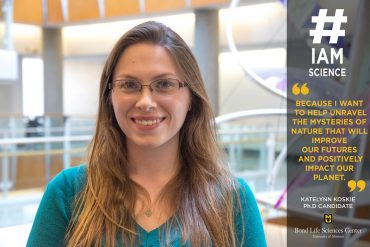
Aug. 11, 2017
Katelynn Koskie #IAmScience
Katelynn Koskie, a Ph.D candidate, works in Mannie Liscum’s lab. | Photo by Samantha Kummerer, Bond LSC By Samantha Kummerer | Bond LSC “#IAmScience because I want to help unravel the mysteries of nature that will improve our futures and positively impact our planet.” Katelynn Koskie didn’t always know she loved plants. As an undergraduate, she focused on what was above her rather than what grew below her. “I was really interested in how galaxies interact and then I started to think, ‘you know I’ve always thought plants were really, really cool,’ and I…
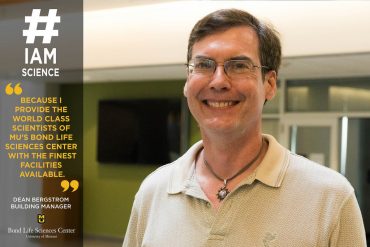
June 6, 2017
Dean Bergstrom #IAmScience
Dean Bergstrom, the new building manager for Bond LSC. | Photo by Mary Jane Rogers, Bond LSC By Mary Jane Rogers | Bond LSC “#IAmScience because I provide the world class scientists of Mizzou’s Bond Life Sciences Center with the finest facilities available.” As the new building manager for the Bond Life Sciences Center, Dean Bergstrom makes it possible for everyone else to focus on his or her research. He’s worked in Bond LSC for nine and a half years as a research technician, and in Tucker Hall eleven years before that. His unique science background and…
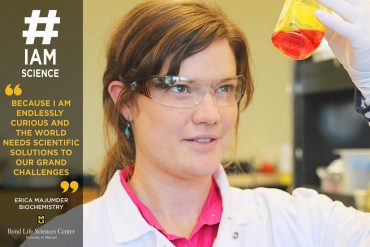
April 26, 2017
Erica Majumder #IAmScience
Erica Majumder, a biochemistry Ph.D candidate. | photo by Morgan McOlash, Bond LSC By Mary Jane Rogers | Bond LSC “#IAmScience because I am endlessly curious and the world needs scientific solutions to our grand challenges.” That is the attitude of someone who does her research with a purpose. Since the age of 14, Erica knew she wanted to pursue a degree in chemistry. Today, she uses that passion to research how anaerobic bacteria interact with uranium; essentially asking the question, “How do microbes and metals interact?” What’s her end game? Improved health of the…
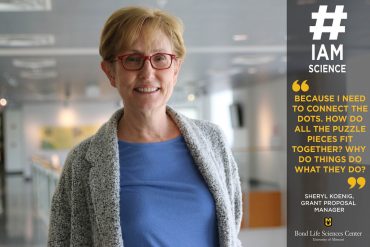
April 5, 2017
Sheryl Koenig #IAmScience
Sheryl Koenig, the Grant Proposal Manager at Bond LSC. | photo by Morgan McOlash, Bond LSC By Mary Jane Rogers | Bond LSC “#IAmScience because I need to connect the dots. How do all the puzzle pieces fit together? Why do things do what they do? How can I apply that to other things?” For Sheryl Koenig, science communication is an enormous part of her daily tasks. She works with researchers and scientists during the grant proposal process to translate technical scientific concepts into persuasive and relevant content. Why? So that those scientists can access…
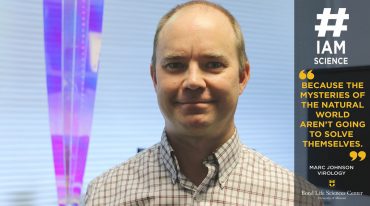
March 22, 2017
Marc Johnson #IAmScience
Marc Johnson, a virology professor at Bond LSC. | photo by Morgan McOlash, Bond LSC By Mary Jane Rogers | Bond LSC “#IAmScience because the mysteries of the natural world aren’t going to solve themselves.” Since the third grade, Marc Johnson never wanted to be anything else but a mad scientist. What began as experimenting with sprouting seeds and chemistry sets has blossomed into a career in virology. Specifically, he studies the “moves and countermoves” of viral components, a few hundred thousand at time! His advice for people wondering if science is for them: “If…
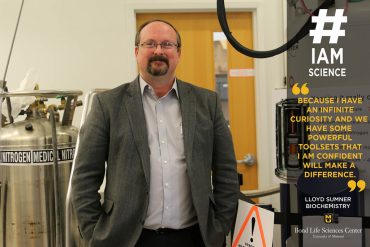
March 15, 2017
Lloyd Sumner #IAmScience
Lloyd Sumner, biochemistry professor and Director of the Metabolomics Center at Bond LSC. | photo by Morgan McOlash, Bond LSC By Mary Jane Rogers | Bond LSC “#IAmScience because I have an infinite curiosity and we have some powerful toolsets that I am confident will make a difference, not just in plant biochemistry, but in many scientific arenas.” What change you would like to see in this world because of your research? “I’m a technology junkie at heart. We are developing tools that can potentially advance many areas, and not just my own personal…
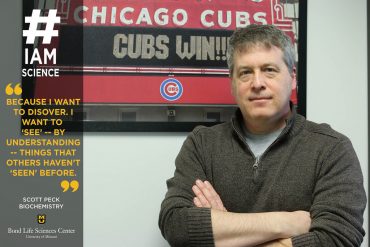
March 8, 2017
Scott Peck #IAmScience
Scott Peck, a biochemistry professor at Bond LSC. | photo by Morgan McOlash, Bond LSC By Mary Jane Rogers | Bond LSC “#IAmScience because I want to discover. I want to ‘see’ – by understanding – things that others haven’t ‘seen’ before.” Every day we make decisions based off on what we encounter in the environment. Plants do the same thing. Scott Peck, a Chicago-area native, is a biochemist who studies how plants translate information they receive about the environment (such as changes in light and temperature) into their own chemical “decisions”, also known as signal transduction.
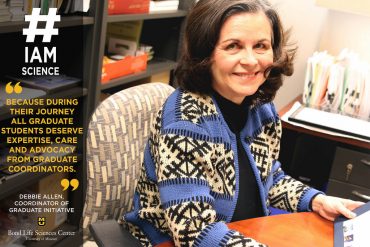
Feb. 22, 2017
Debbie Allen #IAmScience
Debbie Allen, the Coordinator of Graduate Initatives at Bond LSC. | photo by Morgan McOlash, Bond LSC By Mary Jane Rogers | Bond LSC “#IAmScience because during their journey all graduate students deserve expertise, care and advocacy from graduate coordinators.” As Coordinator of Graduate Life Science Initiatives, Debbie Allen facilitates several activities supporting graduate recruitment, training, mentoring and career services. In other words, she’s been the “mama bear” to many life sciences graduate students over the years, and is passionate about student advocacy. To Debbie, while understanding the hard science her students study is important,…

Feb. 15, 2017
Pork without the Pig
This screenshot of a supplemental video included in Genovese’s study shows cultured pork cells contracting in response to a neurotransmitter. | photo courtesy of the Nicholas Genovese What if you could have pork without the pig? Nicholas Genovese’s cultured meat could provide a more environmentally friendly meat By Eleanor C. Hasenbeck | MU Bond Life Sciences Center Scientists are one step closer to that reality. For the first time, researchers in the Roberts’ lab at Bond Life Sciences Center at MU were able to create a framework to make…
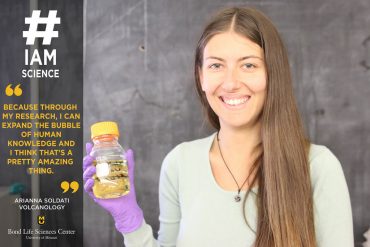
Feb. 15, 2017
Arianna Soldati #IAmScience
Arianna Soldati, a Ph.D candidate in volcanology at Bond LSC. | photo by Morgan McOlash, Bond LSC By Mary Jane Rogers | Bond LSC “#IAmScience because through my research, I can expand the bubble of human knowledge and I think that’s a pretty amazing thing. We don’t have a volcano, so we make our own.” Imagine stirring rock. Sounds impossible? Not to Arianna Soldati, a volcanology expert conducting #MizzouResearch on the viscosity of rock. By heating and then stirring rocky material in a machine that acts like a miniature volcano, she identifies its viscosity, or thickness. As someone…
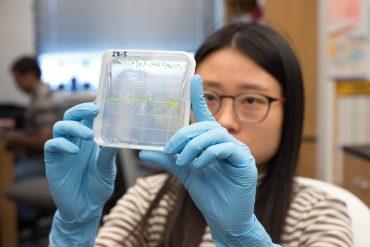
Feb. 7, 2017
Growing a more nourishing future
Nga Nguyen hopes to apply her research to increase nutrient contents in crop plants By Eleanor C. Hasenbeck | Bond LSC Nga Nguyen, a doctoral candidate in MU’s Division of Plant Sciences, observes samples of a model plant species, Arabidopsis thaliana, in the Mendoza-Cózatl lab at Bond Life Sciences Center on Feb. 7, 2017. | photo by Eleanor C. Hasenbeck, Bond LSC Plants smell better than animals, at least to Nga Nguyen. That’s one reason why she decided to study them. “In my undergrad, I studied horticulture,” Nguyen said. “For that you don’t really learn…
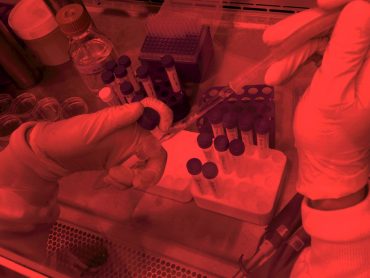
Oct. 9, 2014
The only thing you need to read about Ebola today: An expert Q&A
Jingyou Yu, a graduate student, does cell surface staining in Shan-Lu Liu’s virology lab. The staining illuminates cell marker expressions in experiments that deduce how viruses spread once they are contracted. | Paige Blankenbuehler News headlines seem to feverishly spread as if they were a pandemic of the brain. Ebola hemorrhagic fever has been the most talked about disease of the year, appearing in thousands of headlines across the world since May. Through the noise of misinformation and sensationalism, fundamental information about the pandemic becomes harder to distinguish. In an interview with Decoding Science on Tuesday, Shan-Lu Liu, MD,…